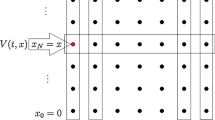Abstract
This paper develops stochastic receding horizon control for a constrained index tracking problem. By modeling the asset dynamics in the problems as a linear system subject to state and control multiplicative noise, and approximating linear chance constraints with quadratic expectation constraints, we show that index tracking can be approached using stochastic receding horizon control. In particular, we use a closed loop version of stochastic receding horizon control where the on-line optimization is solved as a semi-definite program. Numerical examples demonstrate the computations involved in these problems and indicate that stochastic receding horizon control is a promising new approach to constrained index tracking.
Similar content being viewed by others
References
Albert A. (1969) Conditions for positive and nonnegative definiteness in terms of pseudoinverses. SIAM Journal on Applied Mathematics 17(2): 434–440
Batina, I., Stoorvogel, A. A., & Weiland, S. (2002). Model predicitive control of linear, stochastic systems with state and input constraints. In Proceedings of Conference on Decision and Control (pp. 1564–1569). Las Vegas, Nevada.
Beasley J.E., Meade N., Chang T.-J. (2003) An Evolutionary Heuristic for the Index Tracking Problem. European Journal of Operational Research 148(3): 621–643
Birge, J. R., & Louveaux, F. (1997). Introduction to Stochastic Programming. Springer Verlag.
Cannon M., Kouvaritakis B., Tsachouridis V. (2004) Recent developments in stochastic MPC and sustainable development. Annual Reviews in Control 28: 23–35
Couchman, P., Kouvaritakis, B., & Cannon, M. (2006a). MPC on state space models with stochastic input map. In Proceedings of 45th IEEE Conference on Decision and Control (pp. 3216–3221).
Couchman P.D., Cannon M., Kouvaritakis B. (2006b) Stochastic MPC with inequality stability constraints. Automatica 42: 2169–2174
El Ghaoui L. (1995) State-feedback control of systems with multiplicative noise via linear matrix inequalities. Systems & Control Letters 24: 223–238
Findeisen R., Imsland L., Allgöwer F., Foss B.A. (2003) State and output feedback nonlinear model predictive control: An overview. European Journal of Control 9(2–3): 190–206
Gaivoronski A.A., Krylov S., van der Wijst N. (2005) Optimal portfolio selection and dynamic benchmark tracking. European Journal of Operational Research 163: 115–131
García, C. E., Prett, D. M., & Morari, M. (1989). Model predictive control: Theory and practice—A survey. Automatica, 25(3).
Herzog, F. (2005). Strategic Portfolio Management for Long-Term Investments: An Optimal Control Approach. PhD thesis, ETH Zurich, Zurich, Switzerland, 2005.
Herzog F., Dondi G., Geering H. (2007a) Stochastic model predictive control and portfolio optimization. International Journal of Theoretical and Applied Finance 10(2): 203–233
Herzog F., Dondi G., Keel S., Schumann L., Geering H. (2007b) Solving ALM problems via sequential stochastic programming. Quantitative Finance 7(2): 231–244
Herzog, F., Keel, S., Dondi, G., Schumann, L. M., & Geering, H. P. (2006). Model predictive control for portfolio selection. In Proceedings of the 2006 American Control Conference (pp. 1252–1259). Minneapolis, Minnesota.
Jeurissen, R., & van den Berg, J. (2005). Index tracking using a hybrid genetic algorithm. In 2005 ICSC Congress on Computational Intelligence Methods and Applications.
Kwiatkowski J.W. (1992) Algorithms for index tracking. IMA Journal of Mathematics Applied in Business and Industry 4: 279–299
Mayne D.Q., Rawlings J.B., Rao C.V., Scokaert P.O.M. (2000) Constrained model predictive control: stability and optimality. Automatica 36: 789–814
Meindl, P., & Primbs, J. (2004). Dynamic hedging with stochastic volatility using receding horizon control. In Proceedings of Financial Engineering Applications (pp. 142–147). Cambridge, MA, November 8–10 2004.
Meindl P., Primbs J. (2008) Dynamic hedging of single and multi-dimensional options with transaction costs: A generalized utility maximization approach. Quantitative Finance 8(3): 299–312
Peaucelle, D., Henrion, D., Labit, Y., & Taitz, K. (2002). User’s guide for seDuMi interface 1.04. September 2002.
Penrose R. (1955) A generalized inverse for matrices. Proc. Cambridge Phil. Soc. 51: 406–413
Primbs, J. A. (2007a). A soft constraint approach to stochastic receding horizon control. In Proceedings of the 46th Conference on Decision and Control, (pp. 4797–4802). New Orleans, LA, December 2007.
Primbs, J. A. (2007b). Stochastic receding horizon control of constrained linear systems with state and control multiplicative noise. In Proceedings of the American Control Conference, New York, NY.
Rudolf M., Wolter H.-J., Zimmermann H. (1999) A linear model for tracking error minimization. Journal of Banking and Finance 23: 85–103
Sturm, J. (2004). SeDuMi: version 1.05, October 2004.
van Hessem, D. H., & Bosgra, O. H. (2003). A full solution to the constrained stochastic closed-loop MPC problem via state and innovations feedback and its receding horizon implementation. In Proceedings of the 2003 Conference on Decision and Control. Maui, Hawaii, USA, December 2003.
Yao D.D., Zhang S., Zhou X.Y. (2001) Stochastic linear-quadratic control via semidefinite programming. SIAM Journal of Control Optimization 40(3): 801–823
Yao, D. D., Zhang, S., & Zhou, X. Y. (2006). Tracking a financial benchmark using a few assets. Operations Research, 54(2), 232–246, March–April 2006.
Author information
Authors and Affiliations
Corresponding author
Additional information
C. H. Sung completed this work while he was a graduate student in the Management Science and Engineering Department, Stanford University.
Rights and permissions
About this article
Cite this article
Primbs, J.A., Sung, C.H. A Stochastic Receding Horizon Control Approach to Constrained Index Tracking. Asia-Pac Finan Markets 15, 3–24 (2008). https://doi.org/10.1007/s10690-008-9073-1
Published:
Issue Date:
DOI: https://doi.org/10.1007/s10690-008-9073-1




